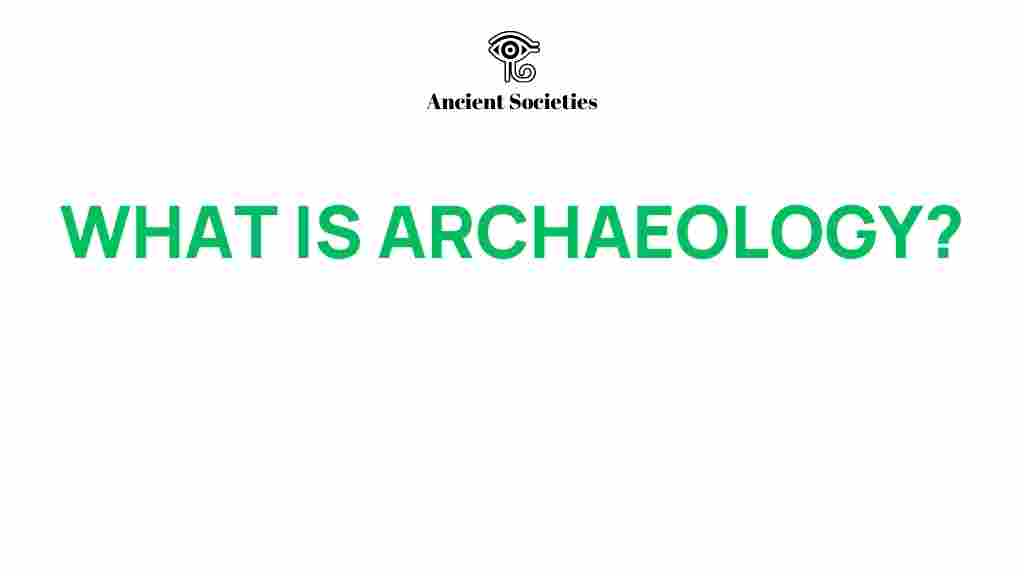Archaeology: Unveiling the Mysteries of Ancient Civilizations
Archaeology is a fascinating field that bridges the past and present, offering insights into ancient civilizations and their cultures through the study of artifacts and historical discoveries. As we embark on this journey through time, we will explore the significance of excavation, cultural heritage, preservation, research, and the role of anthropology in understanding our human history. This article will guide you through the essential elements of archaeology, how it contributes to our understanding of ancient societies, and the importance of preserving our historical legacy.
The Importance of Archaeology
Archaeology plays a crucial role in piecing together the complex puzzle of human history. It helps us to:
- Understand ancient civilizations: By studying artifacts, archaeologists can infer how people lived, what they valued, and how they interacted with their environments.
- Preserve cultural heritage: Excavation and research contribute to the preservation of sites and artifacts that are vital for future generations.
- Inform modern society: Insights from archaeological research can influence contemporary issues such as urban planning, cultural identity, and environmental sustainability.
Key Concepts in Archaeology
To appreciate the depth of archaeology, it’s essential to understand some of its foundational concepts:
- Artifacts: Objects made or used by humans, such as tools, pottery, and jewelry, which provide direct evidence of past cultures.
- Excavation: The systematic process of uncovering and recording archaeological sites, which involves careful planning and methodology.
- Cultural heritage: The legacy of physical artifacts and intangible attributes of a group or society, which must be protected and preserved.
- Research: The ongoing investigation and analysis of findings that contribute to our understanding of past civilizations.
- Anthropology: The study of humans, which intersects with archaeology to provide a comprehensive view of human behavior and culture.
The Excavation Process
Excavation is one of the most critical aspects of archaeology. Here’s a step-by-step process of how archaeologists conduct excavations:
- Site Selection: Choosing a site based on historical records, topography, and previous findings. This often includes extensive background research.
- Surveying: Conducting surface surveys to identify potential archaeological features and artifacts.
- Planning: Developing a detailed plan for the excavation, including the layout of grid squares and the documentation process.
- Digging: Carefully removing soil in layers to uncover artifacts while preserving contextual information.
- Recording: Documenting findings meticulously through photographs, drawings, and notes to maintain a thorough record of the excavation.
- Analysis: Analyzing the artifacts and ecofacts to draw conclusions about the site and its historical significance.
- Preservation: Implementing measures to protect the artifacts and site from deterioration after excavation.
Challenges in Archaeology
While archaeology offers a wealth of knowledge, it also comes with its challenges. Here are some common issues faced by archaeologists:
- Environmental Factors: Natural elements such as weather, erosion, and vegetation can hinder excavation efforts and damage sites.
- Funding and Resources: Many archaeological projects struggle with limited funding, impacting the scope and duration of research.
- Legal and Ethical Issues: Navigating the complexities of land ownership, cultural sensitivity, and the ethical implications of excavation can be challenging.
- Public Interest: Engaging the public and raising awareness about the importance of archaeology and cultural heritage preservation is crucial.
Preservation of Artifacts and Sites
Preserving artifacts and archaeological sites is vital for maintaining our cultural heritage. Here are some methods used in preservation:
- Conservation: The process of stabilizing and restoring artifacts to prevent deterioration.
- Site Management: Developing strategies to protect archaeological sites from urban development and environmental threats.
- Public Education: Raising awareness about the significance of archaeological findings and the need for preservation through workshops, museums, and community programs.
The Role of Technology in Archaeology
Advancements in technology have transformed archaeological practices, making research and excavation more efficient and effective. Some technological innovations include:
- Ground Penetrating Radar (GPR): A non-invasive method to survey subsurface features without excavation.
- 3D Scanning: Creating detailed digital models of artifacts and sites for analysis and preservation.
- GIS (Geographic Information Systems): Analyzing spatial relationships between artifacts and sites to uncover patterns in ancient human behavior.
Research and Collaboration in Archaeology
Collaboration is key in archaeological research. Archaeologists often work alongside historians, anthropologists, and local communities to gain a deeper understanding of the past. Some ways research is conducted include:
- Interdisciplinary Studies: Combining knowledge from various fields to enrich archaeological interpretations.
- Community Involvement: Engaging local communities in research and preservation efforts fosters a sense of ownership and pride in cultural heritage.
- Publishing Findings: Sharing research outcomes through academic journals, conferences, and public presentations helps disseminate knowledge and encourages further inquiry.
Conclusion: The Future of Archaeology
As we continue to explore the mysteries of archaeology, it is essential to recognize its significance in understanding ancient civilizations and preserving our cultural heritage. The ongoing research, excavation, and preservation efforts contribute not only to our knowledge of the past but also to shaping our future. By embracing modern technology and fostering collaboration, we can enhance our archaeological practices and ensure that the stories of ancient peoples are not lost to time.
For those interested in delving deeper into archaeology, consider exploring resources such as the Society for American Archaeology or local archaeological societies that offer opportunities for volunteering and educational programs. Together, we can contribute to the preservation and appreciation of our shared history.
This article is in the category Archaeology and created by AncientSocieties Team
